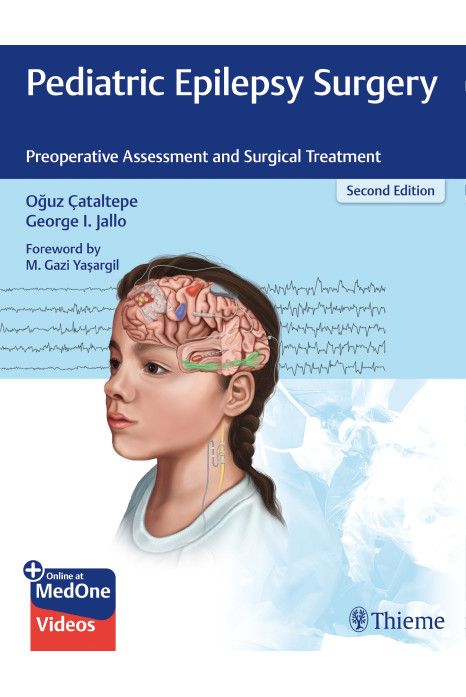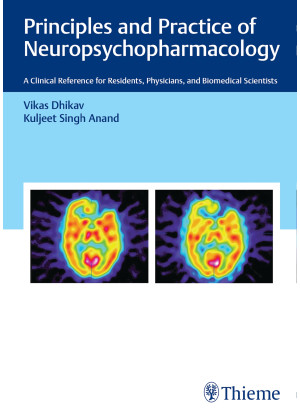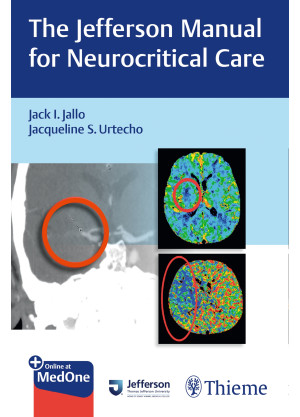The definitive guide to surgical management of epilepsy in pediatric patients
This fully revised and updated second edition of Pediatric Epilepsy Surgery, edited by internationally renowned pediatric neurosurgeons and epilepsy surgery experts Oğuz Çataltepe and George Jallo, fills a void in the literature, encompassing the full spectrum of topics related to the surgical treatment of intractable epilepsy and seizures in children. The prodigiously illustrated book and its accompanying videos feature contributions from distinguished specialists in several different countries across a wide range of disciplines.
From epidemiology, genetics, pathology, preoperative electrophysiological assessment and neuroimaging to state-of-the-art surgical approaches, this remarkable resource covers the full depth and breadth of surgical management of pediatric epilepsy. Topics include awake anesthesia, intracranial stimulation and mapping techniques, temporal and extratemporal epilepsy surgery techniques, insular, multilobar and hemispheric surgery approaches, and diverse disconnection, neuromodulation, and ablative procedures. Insights are provided on postoperative issues including seizure control, neuropsychological and psychosocial outcomes, surgical failure and re-operation, and much more.
Key Features
- A review of topographic anatomy of the cerebral cortex and white matter with numerous illustrations provides enhanced understanding of eloquent anatomy.
- Discussion of cutting-edge techniques such as stereo-electroencephalography, multi-modality imaging and tractography, endoscopic and laser ablation approaches in hypothalamic hamartomas, peri-insular quadrantotomy, and various hemispherotomy approaches.
- Overview of common cortical stimulation and mapping techniques including magnetic and electrical stimulation modalities, functional MRI, and the WADA test.
- 13 videos demonstrate seizure semiology, stimulation, awake surgery, hemispherotomy, amygdalohippocampectomy, and endoscopic corpus callosotomy.
This state-of-the-art resource is a must-have for epilepsy surgeons and epileptologists. It will also greatly benefit neurosurgeons, neurologists, clinical neuropsychologists, electrophysiologists, neuroradiologists, residents, fellows, and medical students involved in the assessment and surgical management of epilepsy in pediatric patients.
This book includes complimentary access to a digital copy on https://medone.thieme.com.
Part I. Introduction to Epilepsy in Children
1 Basic Considerations of Pediatric Epilepsy Surgery
2 A Historical Review of Epilepsy Surgery and Its Application in Children
3 Epidemiology of Intractable Epilepsy in Children
4 Genetics in Epilepsy Surgery
5 Surgical Neuropathology of Pediatric Epilepsy
6 Epilepsy and Brain Plasticity
7 Effects of Seizures and Their Comorbidities on the Developing Brain
8 Ethical Considerations in Pediatric Epilepsy Surgery
9 Infantile and Childhood-Onset Catastrophic Epilepsy Syndromes
10 Epilepsy Surgery for Congenital or Early Brain Lesions
Part II. Preoperative Assessment
Section IIa. Preoperative Clinical and Neuropsychological Assessment
11 Intractable Epilepsy in Children and Selection of Surgical Candidates
12 Clinical Semiology in Preoperative Assessment
13 Preoperative Neuropsychological and Cognitive Assessment
Section IIb. Preoperative Electrophysiological Assessment
14 Electroencephalography and Noninvasive Electrophysiological Assessment
15 Invasive Electrophysiological Monitoring
16 Extra- and Intraoperative Electrocortical Stimulation
17 Stereoelectroencephalography
18 Magnetoencephalography
Section IIc. Preoperative Neuroimaging
19 Structural Brain Imaging in Pediatric Epilepsy
20 Functional Magnetic Resonance Imaging in Pediatric Epilepsy Surgery
21 Application of Positron Emission Tomography and Single-Photon Emission Computed Tomography in Pediatric Epilepsy Surgery
22 Multimodality Imaging and Coregistration
Part III. Surgical Anatomy and Mapping Techniques
23 Cerebral Cortex: Embryological Development and Topographical Anatomy
24 Tractographic Anatomy of White Matter
25 Localization of Motor Cortex and Subcortical Pathways Using Functional Magnetic Resonance Imaging and Diffusion Tensor Imaging
26 The Wada Test: Lateralization of Language and Memory
27 Language Lateralization and Localization: Functional Magnetic Resonance Imaging
28 Localization of Eloquent Cortex and White Matter Tracts Under General Anesthesia
29 Cortical Stimulation and Mapping
30 Subcortical Mapping During Intracranial Surgery in Children
Part IV. Surgical Treatment of Epilepsy
Section IVa. Anesthesia
31 Anesthetic Considerations and Postoperative Intensive Care Unit Care in Pediatric Epilepsy Surgery
32 Pediatric Awake Craniotomy
Section IVb. Intracranial Electrode Placement for Invasive Monitoring
33 Implantation of Strip, Grid, and Depth Electrodes for Invasive Electrophysiological Monitoring
34 Stereoelectroencephalography in Children: Methodology and Surgical Technique
Section IVc. Temporal Lobe Epilepsy and Surgical Approaches
35 Mesial Temporal Sclerosis in Pediatric Epilepsy
36 Anteromesial Temporal Lobectomy
37 Selective Amygdalohippocampectomy
38 Surgical Management of Lesional Temporal Lobe Epilepsy
39 Surgical Management of MRI-Negative Temporal Lobe Epilepsy
Section IVd. Extratemporal Lobe Epilepsy and Surgical Approaches
40 Surgical Management of Insular–Opercular Epilepsy in Children
41 Focal Cortical Dysplasia: Histopathology, Neuroimaging, and Electroclinical Presentation
42 Surgical Approaches in Cortical Dysplasia
43 Tuberous Sclerosis Complex
44 Resective Epilepsy Surgery for Tuberous Sclerosis Complex
45 Extratemporal Resection and Staged Epilepsy Surgery in Children
46 Supplementary Sensorimotor Area Surgery
47 Rolandic Cortex Surgery
48 Anterior Peri-insular Quadrantotomy
49 Posterior Peri-insular Quadrantotomy
50 Tailored Extratemporal Resection in Children with Epilepsy
51 Surgical Management of MRI-Negative Extratemporal Lobe Epilepsy
52 Surgical Management of Hypothalamic Hamartomas
Section IVe. Hemispheric Surgery Techniques
53 Hemispherectomy and Hemispherotomy Techniques in Pediatric Epilepsy Surgery
54 Multifocal Epilepsy and Multilobar Resections
55 Anatomical Hemispherectomy
56 Hemidecortication for Intractable Epilepsy
57 Functional Hemispherectomy at the University of California, Los Angeles
58 Transsylvian Hemispheric Deafferentation
59 Vertical Parasagittal Hemispherotomy
60 Peri-insular Hemispherotomy
61 Endoscope-Assisted Hemispherotomy
Section IVf. Other Disconnective Procedures
62 Corpus Callosotomy
63 Endoscope-Assisted Corpus Callosotomy with Anterior, Hippocampal, and Posterior Commissurotomy
64 Endoscopic Disconnection of Hypothalamic Hamartomas
65 Multiple Subpial Transections in Children with Refractory Epilepsy
66 Hippocampal Subpial Transection
Section IVg. Neuromodulation Procedures
67 Vagal Nerve Stimulation
68 Cortical and Deep Brain Stimulation
Section IVh. Radiosurgery and Ablative Procedures
69 Radiosurgical Treatment for Epilepsy
70 Stereotactic Laser Ablation for Hypothalamic Hamartomas
71 MRI-Guided Laser Thermal Therapy in Pediatric Epilepsy Surgery
Part V. Postoperative Course and Outcome
72 Surgical Failure and Reoperation
73 Postoperative Seizure Control
74 Postoperative Neuropsychological and Psychosocial Outcome














